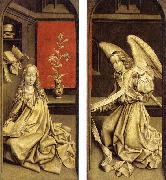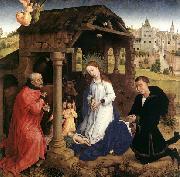
|
WEYDEN, Rogier van der
|
|||
|
|
|||
| Netherlandish Northern Renaissance Painter, ca.1400-1464 | |||
|
|
|||
|
Bladelin Triptych new18/WEYDEN, Rogier van der-833728.jpg Pintura Identificación:: 51145 |
1445-50 Oil on oak panel, 91 x 89 cm | ||
|
|
|||
|
WEYDEN, Rogier van der
|
|||
|
|
|||
| Netherlandish Northern Renaissance Painter, ca.1400-1464 | |||
|
|
|||
|
Bladelin Triptych new21/WEYDEN, Rogier van der-798724.jpg Pintura Identificación:: 63904 |
1480 Oil on oak panel Staatliche Museen, Berlin The exteriors of the wings of the Bladelin Triptych were probably not painted at first; an unknown painter added the Annunciation later, using as a model an engraving by Master FVB, probably active in Bruges 1480-1500, who had been strongly influenced by Rogier van der Weyden.Artist:WEYDEN, Rogier van der Title: Bladelin Triptych (exterior) Painted in 1401-1450 , Flemish - - painting : religious | ||
|
|
|||
|
WEYDEN, Rogier van der
|
|||
|
|
|||
| Netherlandish Northern Renaissance Painter, ca.1400-1464 | |||
|
|
|||
|
Bladelin Triptych new21/WEYDEN, Rogier van der-377823.jpg Pintura Identificación:: 63907 |
1445-50 Oil on oak panel, 91 x 40 cm Staatliche Museen, Berlin The scenes in the side panels depict the advent of the Son of God on earth being announced in miraculous visions to the Roman emperor Octavian (Augustus) and to the three Magi. The Christ Child receives the homage of both East and West, that is to say the whole world as displayed in the panorama of the open triptych: the West is symbolized by the Roman empire - which was regarded as the direct predecessor of the medieval Holy Roman Empire - the East by the Magi, and between them stands the Holy Land with Bethlehem, to the medieval mind the centre and navel of the world. The visions seen by these ruler are taken from a text popular at the time, but never previously illustrated in this - - the chapter on the Nativity in the Legenda Aurea (Golden Legend, a collection of tales of the saints written around 1270 by the Dominican monk Jacobus de Voragine (1228/29-1298). However, there were certain problems involved in illustrating it in realistic detail. It was particularly difficult to present Octavian's vision of the Madonna on an altar hovering in the sky, not borne up by angels or similar figures. Rogier solved this problem by seating the Virgin on an obviously heavy altar, so closely framed by the opening that she looks almost like a picture within the picture, providing an optical focus. The donor clearly wanted the text of the legend illustrated literally, and he must at first have asked for actual quotations too, although they were eventually omitted, to the benefit of the work as a whole: infrared photography shows that all the scenes originally contained scrolls to hold wording. The left-hand picture, for instance, was to quote the words miraculously heard by Octavian, according to the legend, on seeing the vision: Haec est ara coeli ("This is the altar of Heaven"). However, during the execution of the triptych it obviously became clear that the pictures would make their point even without any explanatory text, and the wording was overpainted. Such a decision cannot have been taken without the consent of the patron who commissioned the altarpiece, and perhaps it may have been made during a conversation between Rogier and his client when the latter visited the artist's studio.Artist:WEYDEN, Rogier van der Title: Bladelin Triptych (left wing) Painted in 1401-1450 , Flemish - - painting : religious | ||
|
|
|||
|
WEYDEN, Rogier van der
|
|||
|
|
|||
| Netherlandish Northern Renaissance Painter, ca.1400-1464 | |||
|
|
|||
|
Bladelin Triptych new21/WEYDEN, Rogier van der-733429.jpg Pintura Identificación:: 63918 |
1445-50 Oil on oak panel, 91 x 89 cm Staatliche Museen, Berlin The centre of the triptych shows the Nativity of Christ. The donor wore clothes of a similar fashion to those occurring in Rogier's miniature in the Hainault Chronicle. Apart from the fact that the donor's coat is not made of costly brocade, it greatly resembles the one worn by the duke in the miniature. Unlike Philip, who as the highest-ranking person present keeps on his hat, the "chaperon," the donor in the triptych, kneeling before the Christ Child, has removed his, and wears it slung behind him on his back. The donor of the Middleburg Altarpiece is more closely integrated with the scene than in almost any other Early Netherlandish painting. In his position and attitude he takes the place, within the Nativity narrative, of a shepherd praying, a motif frequent in pictorial tradition. Even in Rogier's Crucifixion Triptych (Kunsthistorisches Museum, Vienna), the married couple who commissioned the work are much more obviously outside the events shown, because their attitude of prayer cannot be seen as part of the narrative. But the donor of the Middelburg Altarpiece too is present only in spirit, witnessing the incarnation of God in his meditations. In order to put sufficient distance between him and the Virgin, the artist has resorted to a device already found in the Deposition (Prado, Madrid): the contours of his figure come very close to other items in the pictorial area, but overlap them to a minimal extent. The donor's head comes short of the ruined wall confining the area containing the Virgin, his hands are close to the outline of her dress but do not quite touch it, and the outline of his coat runs past Mary's robe with only a very slight overlap. The man is kept within a vertical area of the painting (an effect reinforced by the black he wears), an area also containing the fine town with its worldly bustle that is his real environment, although here, of course, it represents Bethlehem. The gap in the little wall behind the donor on the right denotes the road he has taken away from everyday life in his piety, an idea also suggested by the end of his head-dress lying on the ground. A carefully calculated equilibrium is perceptible in the composition. There are three large figures on each panel - even the left-hand panel, where the emperor's two advisers at the back are in fact almost hidden by the one in front. The group around the Christ Child describes an upward-pointing triangle, balanced by a downward-pointing triangle created by the outline of the diagonally placed ruin and the two holes in the foreground, which are set on a slant. This surface pattern in the shape of a horizontal rhomboid, however, also creates depth, since the corner of the ruin projecting forward and the figures graduated in a sequence moving backward interlock spatially. But as usual, Rogier restricts the back part of the stage on which his main figures are set: the back wall of the ruin, the wall of Octavian's apartment, and the hill behind the Magi all act as visual barriers at about the same depth. The main purpose of the triangular composition, however, is to emphasize the Virgin Mary, particularly since she is placed approximately on the central axis of the picture. This position might seem natural, but is in fact unusual in depictions of the Nativity, where Mary is generally placed to one side, next to the Child. The dark wall also acts as a contrasting background and forms a kind of baldachin over Mary. This manner of depicting the Virgin was another of Rogier's successful ideas, imitated by many other artists.Artist:WEYDEN, Rogier van der Title: Bladelin Triptych (central panel) Painted in 1401-1450 , Flemish - - painting : religious | ||
|
|
|||
|
WEYDEN, Rogier van der
|
|||
|
|
|||
| Netherlandish Northern Renaissance Painter, ca.1400-1464 | |||
|
|
|||
|
Bladelin Triptych new21/WEYDEN, Rogier van der-253674.jpg Pintura Identificación:: 63930 |
1445-50 Oil on oak panel, 91 x 40 cm Staatliche Museen, Berlin The scenes in the side panels depict the advent of the Son of God on earth being announced in miraculous visions to the Roman emperor Octavian (Augustus) and to the three Magi. The Christ Child receives the homage of both East and West, that is to say the whole world as displayed in the panorama of the open triptych: the West is symbolized by the Roman empire - which was regarded as the direct predecessor of the medieval Holy Roman Empire - the East by the Magi, and between them stands the Holy Land with Bethlehem, to the medieval mind the centre and navel of the world. The three pictures in the triptych are united not so much by their background setting as by the figures. These are all on the same scale, and are linked to create a compositional line running through the three panels: arranged on both wings in a semi-circle turning in, and on the central panel in a semi-circle turning out, they curve rhythmically in an undulating line - a good example of Rogier's "sense of rhythm." The panels are also linked by the skillful distribution of colour, with the red robe of the oldest king on the right, for instance, echoing the red garments of St. Joseph on the central panel, while the red-patterned gold brocade worn by the central king is matched by Octavian's robe on the opposite wing. These mirror-image correspondences are slightly shifted toward the central axis, and there are many other interrelating colour notes. However, the colour also has other meanings. On the wings, where it is distributed in smaller areas over the surface of the picture and is thus more varied, it illustrates the secular magnificence of earthly rulers, while on the central panel the symphony of red, white and black makes a nobler and sterner effect. Symbolically, white stands for Mary's virginity, while the black worn by the donor was the fashionable colour of the upper classes of the time. The colour composition of the altarpiece as a whole, constantly balancing its slight asymmetries, is well calculated, although ultimately the impression is of rather too regular a kind of diversity, without deep meaning or resonance.Artist:WEYDEN, Rogier van der Title: Bladelin Triptych (right wing) Painted in 1401-1450 , Flemish - - painting : religious | ||
|
|
|||
|
Also Buy::. For Following Paintings / Artists / Products, Please Use Our Search Online: |










